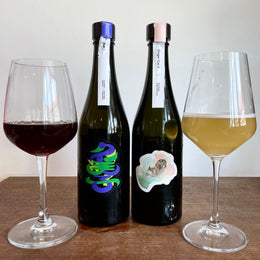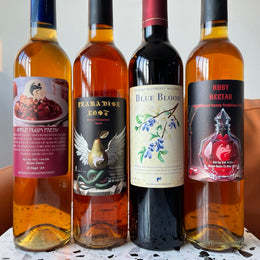Endu: Our First Foray into Sarawak's Native Rice Brew (and the World's First Sparkling Version of It)

I firmly believe that within our Southeast Asian corner of the world lies a whole microcosm of rice fermented drinks - those that are brewed in homes in simple setups, barely making it out of the front door or the kitchen cabinet. And what a sense of discovery when I do come across a lesser known beverage brewing close-by! This time, I've chanced upon not a whole category of rice brews, but one that comes from a heartfelt place intertwined deeply with culture and sense of belonging.
![]()
Sarawak's forested and mountainous landscape. Source: Klook

Our recent tipple adventure takes us to Sarawak, a piece of land that sits on the northwestern corner of Borneo Island, Malaysia. Sarawak in particular is home to people of many cultures and ethnic backgrounds, mainly the: Iban, Chinese, Malay, Bidayuh, Melanau, and Orang Ulu, amongst other smaller but substantial populations of regional peoples. The Iban, Bidayuh, Orang Ulu and others are given the official "Dayak" status, a status given to people and tribes native to Borneo.
![]()
A rice field, or "padi" in Sarawak. Source: Sarawak Tourism
The Sarawak region has been known for rice cultivation - in fact, there are quite a few native rice strains that originate from the place. Some of these rice grains are of heirloom varieties, cultivated and passed down from generation to generation. In fact, recent efforts by the Malaysian government seeks to promote more rice cultivation in Sarawak, effectively becoming Malaysia's backyard rice bowl.

There are over 100 heirloom varieties of rice in Sarawak, with the most famous being the Bario rice, that comes in purple, white and red varieties. Source: @bariorice on X.com
What about rice brews? Tuak, as it's called, is Sarawak's term for rice wine: usually made from glutinous rice and yeast (from my research, some recipes use special yeasts such as red rice wine yeast similar to Chinese red rice wine, yeast containing flour and certain native ginger, and more). Tuak plays an important significance in Sarawakian life as well - being used in festivals like the annual Gawai, which celebrates a bountiful harvest.

A tuak demonstration. Source: thirstmag
During the pandemic, Shaun Chang, from Iban heritage, set out on a journey to learn more about his roots. This brought him to learning the brew from his mother, who learnt how to make tuak from her grandmother, who in turn learnt it from her grandmother.
After learning the generational recipe from his mother, Shaun chanced upon a brewmaster, where discussed kindled an interest to breathe something new and fresh to this centuries old liqour - making a naturally carbonated tuak.
![]()
The tuaks from Endu use a combination of glutinous rice and Borneo Bario rice. Source: NST
The company Thirsty Craftsmen Asia was formed, combining heritage and modern brewing know-how. After much trial and error (as it turns out, stepping up from a 100-litre homebrew set-up to a modernised process tenfold in volume is not easy!), the tuak recipes were refined and ready for bottling, and according to Shaun, is the first sparkling tuak to be produced.
![]()
Source: Vulcan Post
The brand "Endu" was given to the modernised tuaks - a term of endearment used to call Shaun's mother, and also translating to "woman" in the Dayak language spoken by the Iban, a tribute to the fermentation artisans who have been keeping the tradition alive from mother to daughter.
![]()
The rhinoceros hornbill, the state bird of Sarawak and national bird of Malaysia, is believed to be the chief of worldly birds by the Iban people. Source: Mono Malaysia.
Malaysia has stopped issuing new licenses for producing alcohol, and currently Endu has to be made in a facility that allows production prior to the new regulation. Shaun nevertheless believes that there will be a chance he would be able to obtain his own license in the future.

I have had the opportunity to try the tuaks, even stumbling upon Shaun himself at the Singapore FHA Expo earlier in the year. Let's get to my first time trying tuak!
Endu Classic, 17% ABV - Review

Nose: I get freshly peeled salak (also known as snakefruit) - imagine the sappy, plantlike, green apple skin-esque malic acid smell you get when you crush unripe fruits that have fallen on the roadside. After the initial funky, vegetal aroma, you get some familiar makgeolli fragrance - a ricey aroma that reminds you of mochi or rice pudding.
Taste: Tastes very much like salak - for those who aren't familiar with the fruit, imagine a cross between a very tart green apple and a lychee, with a minor tropical funk from an underripe lychee. On that front, as it develops on the palate, it turns into a mix between a mangosteen with much of its sweetness removed and green mango. The frizzante (semi-sparkling) texture compliments greatly with the taste.

Finish: The finish gears towards a more drying sensation, like the aftertaste of a white wine. The flavours that linger remind me of guava, alongside a bit of lightly baked rice cracker. The finish is relatively short.
My Thoughts
An interesting mix of tropical fruits on the palate! I wouldn't have guess this was possible from a rice brew - in fact, it speaks more closely of a fruit-based salad made with more exotic harvests from the region. I really appreciate the snakefruit flavours this brew gives, being a fan of snakefruit myself. I think anyone who likes their ciders, fruity sparkling sakes and the like should definitely try this out.
Endu Roselle, 17% ABV - Review
The Endu Roselle is made with roselle, a plant where the hibiscus-like flowers are harvested and used in cooking and making drinks. The Endu Roselle here is intended to taste more like a dessert wine, with a more floral and sweeter character.

Nose: The nose here is more delicate - here, I have to dig a little bit harder. I get mostly pink guava cordial, with a hint of strawberry candy syrup as well. There is a bit of that tart, Ribena-like aroma of freshly plucked roselle.
Taste: Here, the confectionery flavours seem to mirror that closely of the nose as well, where I get lychee cordial and juice this time round. There is some tartness to the tuak, but as a whole, still reminds me of a dilute lychee cordial.

Finish: The finish takes a bit more of an unexpected turn - it finishes much more like a junmai ginjo sake here, with that melon and banana-like flavours you expect to get from a more full bodied, fruity style of sake
My Thoughts
Compared to the classic, the flavours here feel more subtle. While there's more sweetness and fruitiness in this brew, I feel like it could use a bit more tartness and that fruity funk I got from the classic. I would have loved it if I get more rice aromas alongside more tartness to bridge the fruity aromas and the sweetness of the palate, however, I could see this as a good digestif or dessert to a heavy meal.
Conclusion
There's something rather familiar in the tuaks I had from Endu - despite being my first foray into the drink, it felt as if I've been acquainted with the category long ago. I definitely recommend trying out the classic for those who are familiar with their sakes and wines. Here's to more tuaks in the future!

@vernoncelli







